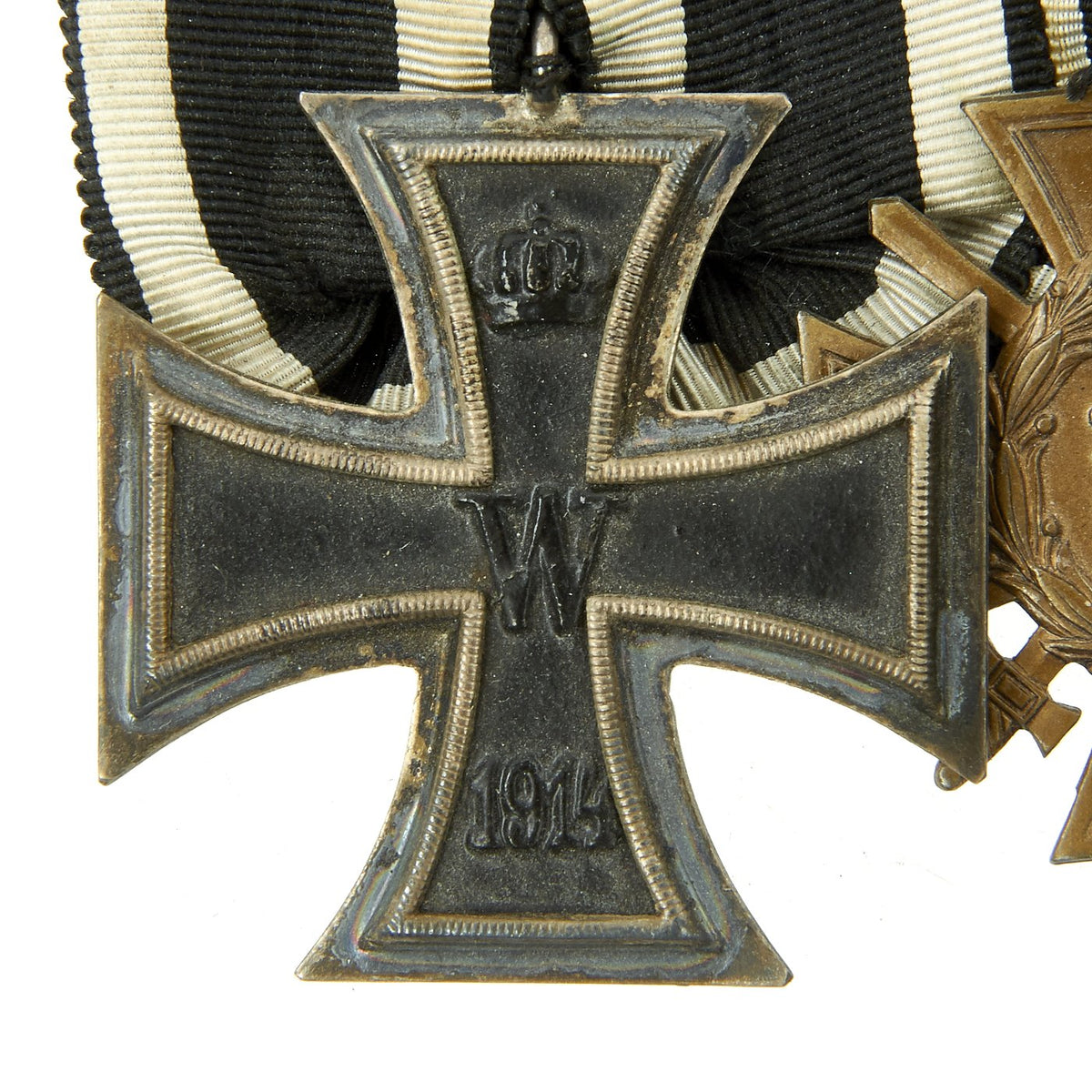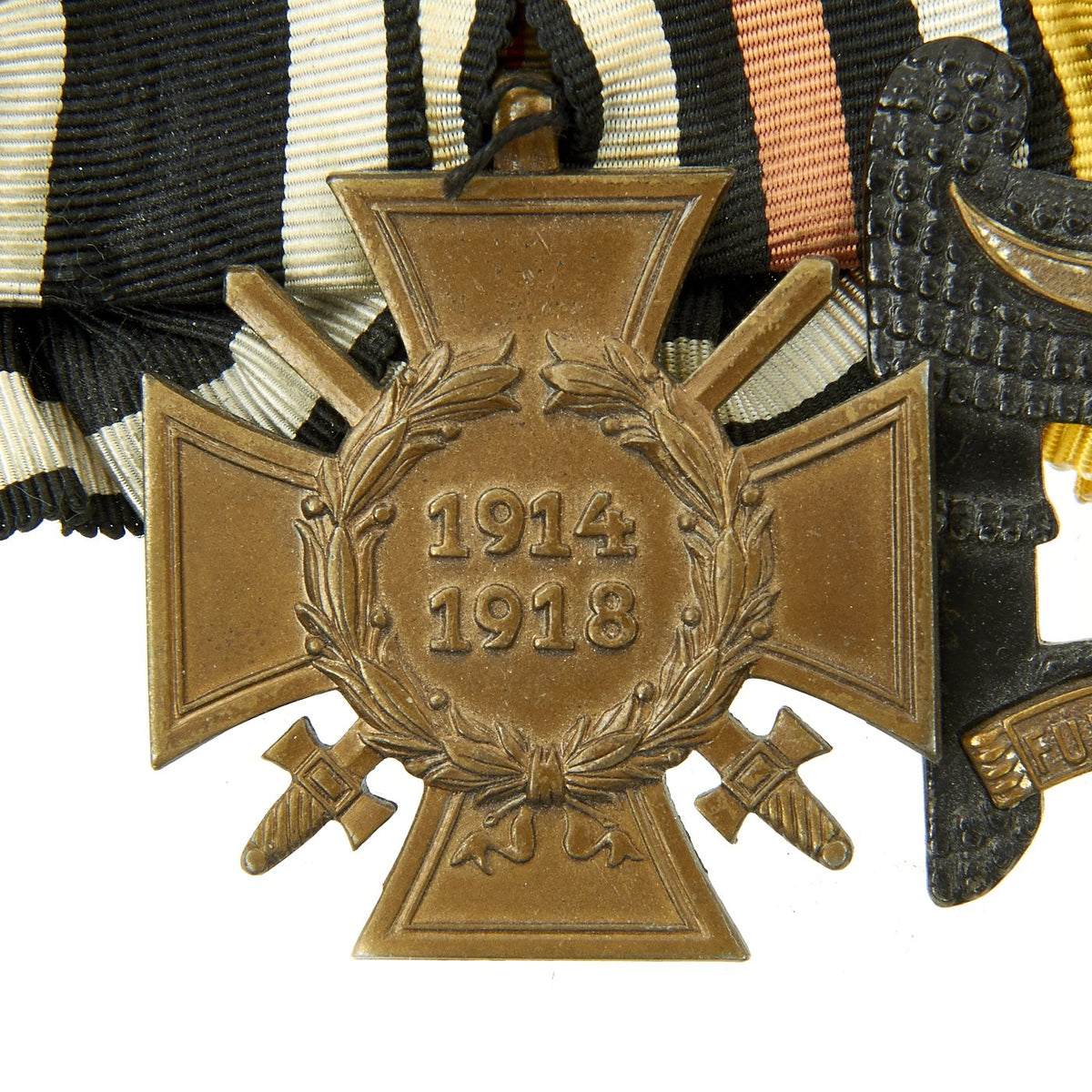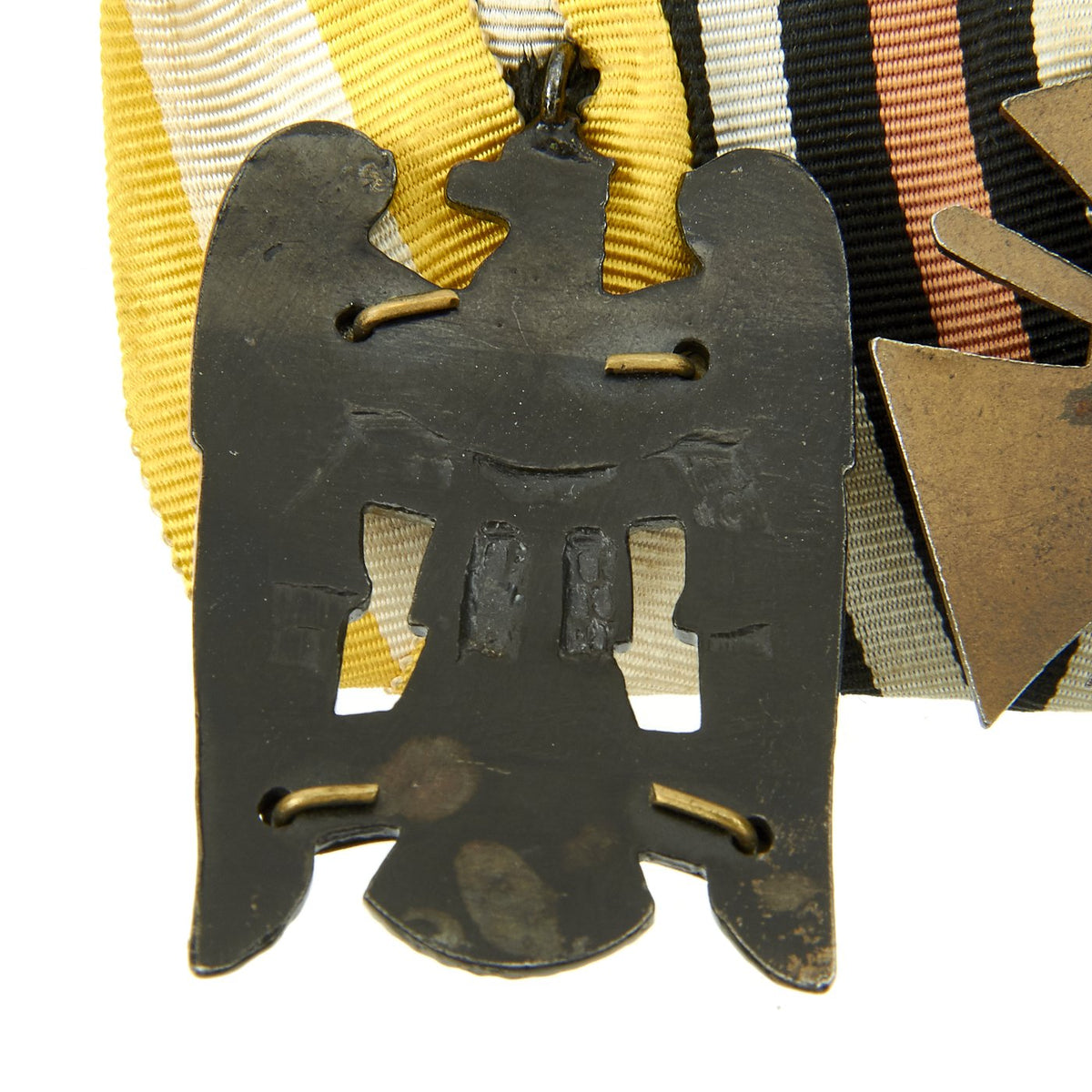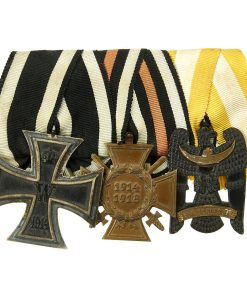Original German WWI Silesian Eagle Medal Bar – 3 Awards Original Items
$ 395,00 $ 118,50
Original Item: One-of-a-kind. This is a very nice genuine medal bar removed from the uniform of a fallen or captured German officer who served in WWI, and probably saw some type of service in WWII.
The set of 3 medals offered in good condition is mounted on a backing board with pin and lined in uniform wool and consists of the following medals:
- Imperial German WWI Iron Cross 2nd Class Medal
– Imperial German WWI Honor Cross of the World War 1914/1918 (Hindenburg Cross) Medal
– Imperial German WWI Silesian Eagle 2nd Class with Yellow and White Ribbon
Below is an explanation of each medal in detail:
German WWI Prussian Iron Cross 2nd Class with Ribbon. Established by Frederick William in 1813 for gallantry in action, the decoration was revived several times for later conflicts. The bulk of the issues are divided into 1st and 2nd class versions, but a rare and superior ‘Grand Cross’ was also awarded for successful field commanders. During WW1 the lower decoration was freely awarded with 5½ million second class types issued. Originally, the Iron Cross was an award of the Kingdom of Prussia, however given Prussia’s pre-eminent place in the German Empire formed in 1871, it became an award for all of Germany.
The basic design of the WW1 crosses is a central cross patee struck from iron and mounted in a silver frame which has a raised crenulated decorative border. The obverse of the cross bears the date 1914 under a crowned ‘W’ monogram. Reverse bears an oak leaf cluster with the date of the decoration’s institution, 1813 underneath – the crowned initials of Frederick William are in the top arm above the oak leaf cluster. Suspension for second-class types is by means of a ring, and frequently this ring bears a maker’s stamp.
Please examine the edge seam for authentication, which is not present on reproductions. Iron crosses were commonly constructed from an iron core sandwiched in a surrounding two part silver frame, normally the seam of these two silver parts is visible around the edge of the cross as is seen on this fine example.
The Honor Cross of the World War 1914/1918 (German: Das Ehrenkreuz des Weltkriegs 1914/1918), commonly, but incorrectly, known as the Hindenburg Cross was established by Field Marshal Paul von Hindenburg, President of the German Republic, by an order dated 13 July 1934, to commemorate service of the German people during the First World War. This was Germany’s first official service medal for soldiers of Imperial Germany who had taken part in the war, and where they had since died it was also awarded to their surviving next-of-kin.[1] Shortly after its issuance, the government of NSDAP Germany declared the award as the only official service decoration of the First World War and further forbade the continued wearing of German Free Corps awards on any military or paramilitary uniform of a state or NSDAP Party organization.
The Honor Cross was awarded in three forms:
– for front-line veterans, with swords
– for non-combatant veterans, without swords
– for surviving widows and parents of fallen participants in the war, without swords.
The Honour Cross was modeled on the reverse side of the War Commemorative Medal of 1870/71 (Preußen Kriegsdenkmünze 1870-1871), and was designed by Eugene Godet. The medal awarded to combatants (the Frontkämpferkreuz) displayed a laurel wreath encircling a medallion, with the dates “1914 1918”. Crossed swords are between the arms. The reverse side was plain, except for the manufacturer’s logo. The Honour Cross for non-combatants has no swords and a wreath of oak leaves. Both crosses are in bronze. The Honour Cross for Next-of-Kin (commonly known as the Widows Cross), was finished in black.
The Honor Cross was worn suspended from a ribbon with black edge stripes, two white stripes, two black stripes and a red stripe in the middle between them. The ribbon for the Honor Cross for Next-of-Kin had these colors in a different order, having a white edge stripes, with two black stripes, white stripes on either side of a red stripe in the middle They were frequently worn with the ribbon fashioned into a bow, with a pin on the back, which the mother or widow in question attached to her clothing. The application for this award had a time limit, which expired at the end of 1942. Each award came with an Urkunde, or certificate, which indicated which form the award took. The certificates for the next-of-kin crosses came in two types: those for widows were titled Ehrenkreuz für Witwen (Honour Cross for Widows), those for parents Ehrenkreuz für Eltern (Honour Cross for Parents).
The Silesian Eagle (German language: Schlesischer Adler) was a medal awarded for fighting the Silesian Uprisings as part of the Freikorps Oberland under the Weimar Republic. Instituted on the 19 of June 1919 by VI. Armee-Korps Generalleutnant Friedrich von Friedeburg, the Silesian Eagle was issued in two classes, 2nd class for three months of service and 1st class for 6 months of service and could be adorned with oak leaves, swords, or both. This medal was one of the few Freikorps awards that were allowed to be worn on uniforms during the Third Reich after the 1935 ban on unofficial medals. However, the swords, and oak leaves, denoting additional bravery, merit or service were banned, but despite interdictions, many veterans continued wearing them in active military service during WWII.
Fast Shipping with Professional Packaging
Thanks to our longstanding association with UPS FedEx DHL, and other major international carriers, we are able to provide a range of shipping options. Our warehouse staff is expertly trained and will wrap your products according to our exact and precise specifications. Prior to shipping, your goods will be thoroughly examined and securely secured. We ship to thousands clients each day across multiple countries. This shows how we're dedicated to be the largest retailer on the internet. Warehouses and distribution centres can be located throughout Europe as well as the USA.
Note: Orders with more than one item will be assigned a processing date depending on the item.
Before shipping before shipping, we'll conduct a thorough inspection of the items you have ordered. Today, the majority of orders will be delivered within 48 hours. The delivery time will be between 3-7 days.
Returns
The stock is dynamic and we cannot completely manage it because multiple stakeholders are involved, including our factory and warehouse. So the actual stock may alter at any time. It's possible that you may not receive your order once the order has been made.
Our policy is valid for a period of 30 days. If you don't receive the product within 30 days, we are not able to issue a refund or an exchange.
You can only return an item if it is unused and in the same state as the day you received it. You must have the item in its original packaging.
Related products
Uncategorized
Uncategorized
Uncategorized
Band of Brothers ORIGINAL GERMAN WWII Le. F.H. 18 10.5cm ARTILLERY PIECE Original Items
Uncategorized
Uncategorized
Uncategorized
Uncategorized
Uncategorized
Uncategorized
Uncategorized
Uncategorized
Uncategorized
Angolan Rebel 1970s era 60mm Inert Display Mortar from Angolan Civil War Original Items
Uncategorized
Uncategorized
Uncategorized
Uncategorized
Uncategorized
Australian WWII Owen MK1 Machine Carbine SMG Custom Fabricated Replica with Sling Original Items
Uncategorized
Uncategorized













































































